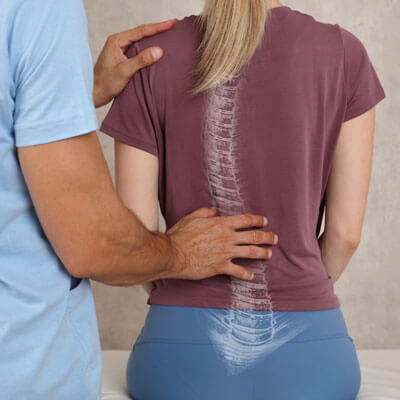Scoliosis Care in Dallas
 Scoliosis is a condition where the spine curves sideways, twisting and rotating out of its natural alignment. Technically, scoliosis is defined as a spinal curvature greater than 17 degrees. However, many people use the term to refer to any level of spinal curvature. This misalignment can range from mild to severe and can affect posture, balance, and overall spinal health.
Scoliosis is a condition where the spine curves sideways, twisting and rotating out of its natural alignment. Technically, scoliosis is defined as a spinal curvature greater than 17 degrees. However, many people use the term to refer to any level of spinal curvature. This misalignment can range from mild to severe and can affect posture, balance, and overall spinal health.
Recognizing the Signs and Symptoms
Common signs of scoliosis can be observed visually. These may include noticeable changes in posture, such as shoulders that appear uneven or hips that are not level. When examining the spine, one might detect the curvature through touch. Scoliosis is often screened during early puberty (ages 10-12), when growth spurts can make these curvatures more pronounced. While some individuals may be asymptomatic, others might experience the following:
- Tightness or soreness in the back
- Pain in different areas of the spine
- Visible unevenness in the shoulder or hip alignment
Chiropractic Approaches to Scoliosis Care
Traditional Chiropractic Adjustments
In traditional chiropractic care, the focus is on manual adjustments to correct the spinal curvature. By applying precise force to specific areas of the spine, chiropractors aim to shift the spine back into a more natural alignment. This method emphasizes ongoing management to reduce or slow the progression of the curvature. Many patients find this approach beneficial in managing their scoliosis, though it primarily serves as a management tool rather than a cure.
NetworkSpinal Approach
NetworkSpinal (NS) takes a different approach. Instead of viewing the spine as “out of alignment,” NetworkSpinal sees the curvature as the body’s response to underlying neurological tension. The premise is that the nervous system directs muscles to contract or relax, thus pulling the spine into its curved position. This tension and the resulting curvature are the body’s defense mechanisms against stress.
NetworkSpinal focuses on reprogramming the neurological signals that cause the muscles to pull the spine out of alignment. By addressing the root cause—neurological tension — NetworkSpinal aims to reduce this tension, allowing the spine to align more naturally to a state of ease and efficiency.
Diagnosis and Treatment Plan
When a patient comes to our office, the process begins with a thorough chiropractic examination. We assess the spinal curvature and focus on identifying the neural programming contributing to this condition. Our goal is to shift this programming so that the spine can release tension and move toward a more efficient alignment.
During the first visit, the patient undergoes a detailed evaluation, including a discussion of symptoms and potential imaging referrals. Treatment plans are customized based on individual needs, with ongoing assessments to monitor progress and make necessary adjustments.
Lifestyle Recommendations
Movement is essential for managing scoliosis. We recommend incorporating various forms of exercise, such as:
- Flexibility exercises (e.g., yoga)
- Cardiovascular workouts
- Strength training
These activities help reinforce neurological pathways and support the muscles in sustaining spinal changes. A sedentary lifestyle can hinder progress, so regular physical activity is crucial for maintaining and improving spinal health.
Schedule an Appointment
If you or a loved one suspect scoliosis or are experiencing symptoms, don’t wait. Early intervention can make a significant difference in managing this condition. Contact Self Unbound today to book an evaluation.

